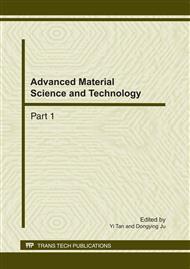p.231
p.235
p.239
p.243
p.247
p.251
p.255
p.259
p.263
Study on Nanometer Size Structures in the Cr-Mo Electroplated Layer Using Transmission Electron Microscopy and Positron Lifetime Measurement
Abstract:
Micro- and nano-structures of the Cr-Mo electroplated layers were studied mainly by Transmission Electron Microscopy (TEM), High Resolution TEM (HRTEM) and Positron Annihilation Lifetime Spectroscopy (PALS). These electroplated layers which were deposited in Cr-Mo electrolyte containing an organic sulfonic acid, showed surface structures having severe ups and downs of small crystal grains. Both selected area diffraction and dark-field image of TEM confirmed the presence of very small crystal grains of less than 50 nm. These small crystal grains exhibited textured structure when the electrolyte contained an organic sulfonic catalyst. PALS results indicated the presence of high density nano-size voids, and HRTEM analysis confirmed the presence of high density voids of 1 nm to 2 nm in diameter. Size and density of these nano-voids increased with the amount of catalyst in the electrolyte.
Info:
Periodical:
Pages:
247-250
Citation:
Online since:
February 2011
Authors:
Price:
Сopyright:
© 2011 Trans Tech Publications Ltd. All Rights Reserved
Share:
Citation:


